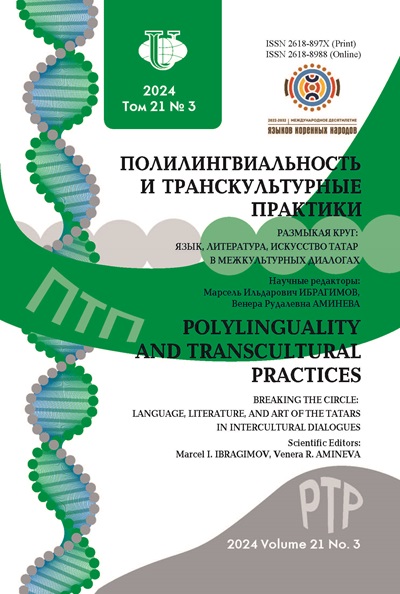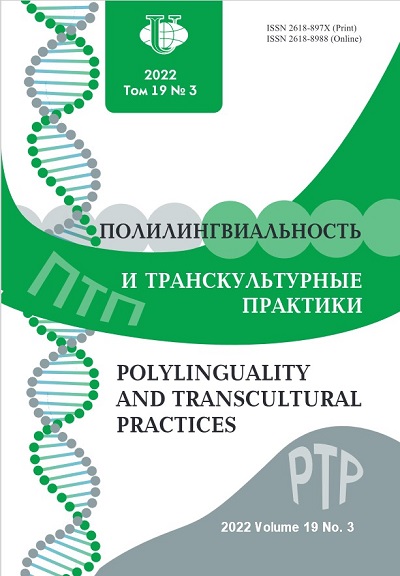Практика преподавания русского языка в системе курсов повышения квалификации учителей русского языка и литературы в Республике Армения
- Авторы: Баласанян Л.Г.1
-
Учреждения:
- Армянский государственный педагогический университет им. Х. Абовяна
- Выпуск: Том 19, № 3 (2022)
- Страницы: 562-568
- Раздел: Арсенал
- URL: https://journals.rudn.ru/polylinguality/article/view/32083
- DOI: https://doi.org/10.22363/2618-897X-2022-19-3-562-568
Цитировать
Полный текст
Аннотация
Рассматриваются некоторые вопросы статуса русского языка для стран СНГ, предлагаются рекомендации по системной организации обучения в инновационной практике. Предложено, в частности, использовать документ «Общеевропейские компетенции владения иностранным языком: изучение, преподавание, оценка» (Common European Framework of Reference, CEFR) как метод оценки уровня владения языком в процессе обучения и определения целей каждого урока. В процессе исследования мы установили, что в Республике Армения из 1350 школ 65 - школы с углубленным изучением русского языка; 45 с русским языком обучения для этнически нерусских детей; 30 - для компактно проживающих национальных меньшинств. Армения - мононациональная страна. Только русский язык использует 5 % населения. Таким образом, методика преподавания русского языка в школах с армянским языком обучения стала своеобразным индикатором определения качества преподавания РКИ (или РКН) и выявления проблем взаимовлияния языков - неизменных процессов транспозиции и интерференции. Проанализировав корпус учебных пособий для школ, разработанных в последнее десятилетие, мы приходим к выводу, что современные учебники познавательно обогащают учащихся в разных областях знания и приобщают к образцам высокой художественности, выполняя тем самым эстетико-воспитательную задачу.
Ключевые слова
Полный текст
Введение Для педагогической общественности стало очевидным, что новый век диктует системам образования всех стран, постсоветского пространства в том числе, серьезный пересмотр содержательной составляющей, требуя формирования и развития межличностных связей на основе культурологических и социальнофилософских ориентаций. Эти вызовы, на наш взгляд, не только «породили» взаимный интерес образовательных сообществ друг к другу, но и предлагают создание инновационного общего пространства для наиболее активного сотрудничества. С каждым годом понимание роли гуманитарного сотрудничества приобретает новый импульс для совместных межгосударственных проектов, способных объединить усилия профессиональных сообществ вокруг действенного партнерства, решающего проблемы сохранения исторически сложившихся не только культурных традиций и связей, но и русского языка как инструмента межнациональн ого общения, языка-переводчика, языка понимания и организации того «гуманитарного сотрудничества», роль и результативность которого переоценить сложно [1]. За постсоветский период в Республике Армения все еще не сформировалось понимание того, каким должен быть статус русского языка, так как попытки рассматривать русский язык как иностранный (РКИ) в обществе не приживается, русский язык как неродной (РКН), к сожалению, мало разработан в теории российской и отечественной методической мысли, язык же межнационального общения, на наш взгляд, не в состоянии определить статус и функции русского языка для системы общего образования [2]. В республике порядка 1350 школ, из них: 65 - с углубленным изучением русского языка; 45 - с русским языком обучения для детей этнических русских, смешанных браков и граждан РФ, где преподавание ведется по российским учебникам и программам; порядка 30 - для детей других компактно проживающих национальных меньшинств. Таким образом, методика преподавания русского языка в школах с армянским языком обучения в мононациональной стране, где более 95% населения говорит на армянском языке, а только 5% (приблизительные цифры) пользуется только русским языком, стала своеобразным индикатором определения качества преподавания РКИ (или РКН) и выявления проблем взаимовлияния языков - неизменных процессов транспозиции и интерференции. В центре внимания современной инновационной практики преподавания русского и иностранных языков оказались разработанные в Европе в 1989-1996 гг. Общеевропейские компетенции владения иностранным языком: изучение, преподавание, оценка (Common European Framework of Reference, CEFR), которые были частью проекта «Изучение языков для европейского гражданства» [3]. Отметим, что резолюция Совета ЕСВ в 2001 г. рекомендовала использование компетенций CEFR для создания национальных систем оценки языковой компетенции. Тогда же классификация компетенций, предложенная в CEFR, вошла в школьные программы и стандарты по русскому языку в Республике Армения с целью предоставить метод оценки, применимый для обучения всем европейским языкам уже в процессе обучения. Изучив критерии первого уровня А(А-1) и дескрипторы владения языком, мы пришли к заключению: этим уровнем владеет практически все население страны, так как русский язык системно преподавали весь советский период и продолжают преподавать во всех государственных и негосударственных образовательных учреждениях Армении (думаем, как и во многих государствах - участниках СНГ). Обсуждение В Армении системные преобразования последних лет были направлены на создание образования национального образца, но через сохранение достижений советского периода и внедрение инновационных практик и методик преподавания, в том числе русского языка. Русский язык преподается в школах (2-12 кл.); в ассирийских школах является основой обучения родному языку; в вузах и в заведениях начального профессионального образования, среднего профессионального образования; во внешкольных учреждениях. В последние годы в образовательной системе возникли сложности из-за пересмотра государственных стандартов по владению иностранными языками, куда (из-за неопределенности статуса) вошел и «иностранный» русский язык (без литературы). Объясняется это тем, что пересмотрена языковая политика и составляющая сотрудничества, что, на наш взгляд, недопустимо именно в силу того, что не учитываются те соответствия, которые изложены в документе «Общеевропейские компетенции владения иностранным языком: изучение, преподавание, оценка». Созданная в Армении гибкая нормативно-правовая база сотрудничества позволяет реализовать всевозможные межгосударственные и межправительственные договоры, но при этом опускается планка владения русским языком фактически рабочего языка сотрудничества. Защитить позиции русского языка обязывает и то обстоятельство, что русский язык является региональным языком, языком национальных меньшинств, ориентирует национальную систему образования на соблюдение и создание поликультурного общества. В школах Армении, где КСО стал методологией общеобразовательной системы, учителя русского языка уделяют особое внимание развитию творческой активности учеников и активизации их интереса к процессу обучения, а интерактивные методы - гарантами доступности, заинтересованности всех участников в процессе и содержании обучения, а также усвоении необходимого объема дополнительной информации. Современный уровень методики преподавания русского языка и литературы в этом контексте можно считать базовым для преподавания других языков, а сам процесс обучения доступным и интересным, если учитываются следующие параметры: - расширение компетенции каждого участника коммуникации за счет общения с другими участниками (ГСО, КСО и т.д.); - «педагогизация» процесса обучения (учащийся в роли учителя) и т.д.; - наполнение содержания обучения материалами и формами обучения с использованием богатейшего материала по диалогу культур. Содержание интерактивных методов, уже вошедших в профессиональный «арсенал» преподавателей русского языка общеобразовательных школ, включает в себя игровую методику, творческие задания (соревнования, конкурсы, спектакли и т.д.); презентаций и т.д. Наблюдения за инновационными проектами позволили сделать вывод о том, что использование информационных технологий, требующее своевременного совершенствования форм и методов преподавания, «страдает» и не позволяет зафиксировать результаты апробации из-за отсутствия системной реализации новых проектов, потому что «одноразовость» мешает качеству усвоения и закреплению учебных материалов. Смущает и пассивное использование имеющихся в большом объеме материалов по диалогу культур. Нельзя не согласиться с Е.И. Пассовым в том, что необходимо создание «модели культуры», в нашем понимании своей и русского народа, которая могла бы в функциональном плане помочь наполнению содержания обучения интересными материалами из литературы и культуры наших народов. По своему объему это содержание, конечно же, меньше того объема информации, который имеется, «но по качественному и системному набору фактов культуры она позволит создать некий аналог действительности, способный аутентично представить всю культуру и выполнить свою главную функцию - дать ученику возможность проникнуть в ментальное пространство народа, преодолеть культурный изоляционизм учащегося, стать преградой на пути ксенофобии и национализма, а, следовательно, послужить основой взаимопонимания» [4]. Обсуждение с учителями проблем организации деятельности учащихся на уроках с применением материалов по диалогу культур и мультимедийных технологий сводится к рассмотрению результативных методов и приемов использования, не к анализу системного использования их и планирования того материала, который надолго останется в памяти. Есть, конечно же, понимание, что, сделав урок интересным, необходимо обеспечить основную задачу - понимание и закрепление темы урока. Преимуществом таких уроков является повышение качества обучения за счет использования дополнительных материалов и мультимедийных презентаций, которые используются не только для выработки умений, навыков и знаний, но и для их повторения, обобщения, систематизации, контроля, автоматизации - успешного выполнения дидактических функций. Организация на уроке дискуссии на тему диалога культур представляет собой такую форму познавательной деятельности учеников, во время которой они обмениваются мнениями, идеями, суждениями, проводят параллели и т.д. В рамках данного подхода в общеобразовательных школах Армении на уроках русского языка и литературы организуются спектакли, разучиваются тексты песен, проводятся мероприятия по приобщению не только к русской культуре, но и культуре этносов, проживающих в Армении и за ее пределами. В 2014 году в издательстве «Филин» под редакцией академика АПСН, доктора педагогических наук Б.М. Есаджанян был издан учебник русского языка новаторского типа, созданный авторским коллективом в составе Б. Есаджанян, Л. Баласанян, Г. Язичян и Т. Барсегян. Учебник под названием «Русский язык. Диалог культур» для 12-го класса школ с армянским языком обучения, надеемся, подтолнул к осознанию необходимости учителей перейти к созданию собственного методического арсенала к урокам - материалов по диалогу культур многих народов. 12-й класс - завершающий класс старшей школы. Диалог культур относится к взаимодействию русской и армянской культур, хотя в учебнике имеется большой материал, относящийся к культуре и других народов, что расширяет его познавательное значение. Учебник не содержит учебно-программного грамматического материала 10- 11-го классов, но рассчитан на знание и усвоение пройденного материала, поэтому он имплицитно присутствует в вопросах, заданиях и упражнениях, широко представленных во всех рубриках книги. Под рубрикой «Собеседник» дается толкование таких слоев лексики, как паронимы - однокоренные слова, не всегда четко различаемые даже носителями русского языка. К этому ряду примыкают и толкования других слов, приводимых в рубрике «Это надо знать!» и в сносках, играющих немалую роль в структуре учебника. Главная задача данного учебника - совершенствование приобретенных знаний, имеющее целью раскрепощенное, свободное пользование русским языком и активизацию познавательной деятельности учащихся. Учебник делится на десять тематически различающихся частей, в названии которых использованы обороты из поэтических произведений: «Через годы, через расстояния…» (На свете лишь одна Армения); «Сквозь разделяющие годы услышал я ту песнь веков…»; «И как художник кистью сущей мир рисует…»; «С любимыми не расставайтесь…» и др. Имеются в книге и подрубрики, всегда связанные с заданиями по развитию речи: «Историческая мозаика», «Литературная мозаика», «Географическая мозаика», «Биографическая мозаика» и др. Подрубрики способствуют расширению кругозора ученика, но подчинены методическим задачам. Диалог культур преподносится как разговор на тему о взаимосвязях и взаимодействии культур и - шире - о дружбе носителей и творцов этих культур. Ведут этот диалог культур ученики устами видных представителей культуры двух народов, которые как бы приглашают читателя к продолжению диалога культур. Учебник «Русский язык. Диалог культур» в 12-м классе не только подводит итог в обучении русскому языку учеников старшей школы, но и обогащает их познавательно в разных областях знания и приобщает к высокой поэзии, выполняя тем самым эстетико-воспитательную задачу. Выводы Для системы образования Армении большим достижением стало то, что учителя стремятся к совершенствованию методов преподавания русского языка и литературы в общеобразовательных школах, стали активнее и сотрудничать и обмениваться опытом как с коллегами в стране, так и за ее пределами. Выделенные нами проблемы организации интерактивных методов по формированию учебных компетенций могут быть, на наш взгляд, применимы при обучении в различных классах с различным уровнем владения русским языком. Успешность решения образовательных проблем, безусловно, может привести к оптимизации самого процесса обучения и повышению его результативности.Об авторах
Лилия Гургеновна Баласанян
Армянский государственный педагогический университет им. Х. Абовяна
Автор, ответственный за переписку.
Email: liliyabalasan@mail.ru
кандидат педагогических наук, доцент кафедры методики преподавания иностранных языков Армянского государственного педагогического университета им. Хачатура Абовяна, президент Армянской ассоциации учителей русского языка и литературы общеобразовательных школ Республика Армения, 0070, Проспект Тиграна Меца, 17
Список литературы
- Баласанян Л.Г., Мариносян Э.Т. Вопросы формирования предметных умений, навыков и знаний на уроках русского языка как иностранного (или неродного) в школах Армении: материалы XII Международной научно-практической конференции Международной академии наук педагогического образования (МАНПО). Т. 2. М., 2020. С. 599-603.
- Баласанян Л.Г. Некоторые вопросы функционирования русского языка в общеобразовательной системе Армении: сборник тезисов Международного конгресса «Языковая политика стран СНГ» (Минск, 2-4 декабря 2019 г.). М.: Государственный институт русского языка им. А.С. Пушкина, 2019.
- Общеевропейские компетенции владения иностранным языком: изучение, преподавание, оценка (Common European Framework of Reference, CEFR). URL: https://mipt.ru/education/chair/foreign_languages/articles/european_levels.php
- Пассов Е.И. Развитие индивидуальности в диалоге культур (Программа-концепция коммуникативного иноязычного образования). М.: Просвещение, 2000.















